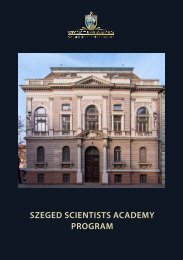Create successful ePaper yourself
Turn your PDF publications into a flip-book with our unique Google optimized e-Paper software.
SZENT-GYÖRGYI MENTORS<br />
MÁRIA DELI<br />
Institute of Biophysics,<br />
Biological Research Center of the<br />
Hungarian Academy of Sciences<br />
Address: Temesvári krt. 62., H-6726 Szeged, Hungary<br />
RESEARCH AREA<br />
Organisms are protected by biological barriers from harmful<br />
effects. These barriers also impede drug penetration.<br />
Our lab investigates methods to increase drug delivery<br />
on culture models of the blood-brain, nasal, lung and<br />
intestinal barriers. The pathways examined are (I.) reversible<br />
opening of tight intercellular junctions by peptides or<br />
small molecules; (II.) targeting solute carriers at barriers for<br />
drug delivery by nanoparticles. Cellular toxicity of active<br />
ingredients and pharmacautical excipients are measured by<br />
a real-time impedance-based method. Double and triple coculture<br />
models are used for experiments, and a microfluidic<br />
integrated chip has been developed in a collaborative<br />
project. Our other major research interest is the examination<br />
of blood-brain barrier injury and dysfunctions in different<br />
diseases, like Alzheimer’s disease, brain tumors, diabetes or<br />
acute pancreatitis. The goal of these experiments is to reveal<br />
the effect of disease pathogenic factors on blood-brain<br />
barrier functions and to identify protective molecules. The<br />
protection of brain endothelial cells and the improvement<br />
of BBB functions in pathological conditions, the exploration<br />
of new approaches for drug transport/targeting to brain<br />
may have therapeutic potential in the treatment of central<br />
nervous system diseases.<br />
TECHNIQUES AVAILABLE IN THE LAB<br />
Mammalian cell culture; primary cultures from brain<br />
and brain microvessels; models of biological barriers<br />
by double and triple co-cultures; cell culture models in<br />
microfluidic chips; electric resistance measurements of<br />
cell layers; permeability of drugs across culture models;<br />
immunohistochemistry; phase contrast, fluorescent and<br />
confocal microscopy; ELISA; measurement of nitric oxide<br />
and reactive oxygen species production in cells; colorimetric<br />
and impedance-based toxicity tests.<br />
SELECTED PUBLICATIONS<br />
Walter, F.R., Valkai, S., Kincses, A., Petneházi, A., Czeller, T.,<br />
Veszelka, S., Ormos, P., Deli, M.A., Dér, A. (2016) Versatile<br />
lab-on-a-chip tool for modeling biological barriers. Sens<br />
Actuators B Chem 222: 1209-12<strong>19</strong>.<br />
Bocsik, A., Walter, F.R., Gyebrovszki, A., Fülöp, L., Blasig, I.,<br />
Dabrowski, S., Ötvös, F., Tóth, A., Rákhely, G., Veszelka, S.,<br />
Vastag, M., Szabó-Révész, P., Deli, M.A. (2016) Reversible<br />
opening of intercellular junctions of intestinal epithelial<br />
and brain endothelial cells with tight junction modulator<br />
peptides. J Pharm Sci 105: 754-765.<br />
Veszelka, S., Tóth, A.E., Walter, F.R., Datki, Z., Mózes, E., Fülöp,<br />
L., Bozsó, Z., Hellinger, E., Vastag, M., Orsolits, B., Környei, Z.,<br />
Penke, B., Deli, M.A. (2013) Docosahexaenoic acid reduces<br />
amyloid-β induced toxicity in cells of the neurovascular<br />
unit. J Alzheimers Dis 36: 487-501.<br />
Hülper, P., Veszelka, S., Walter, F.R., Wolburg, H., Fallier-Becker,<br />
P., Piontek, J. Blasig, I.E., Lakomek, M., Kugler, W., Deli, M.A.<br />
(2013) Acute effects of short-chain alkylglycerols on bloodbrain<br />
barrier properties of cultured brain endothelial cells.<br />
Br J Pharmacol 169: 1561-1573.<br />
Nakagawa, S., Deli, M.A., Kawaguchi, H., Shimizudani, T.,<br />
Shimono, T., Kittel, A., Tanaka, K, Niwa, M. (2009). A new<br />
blood-brain barrier model using brain endothelial cells,<br />
pericytes and astrocytes. Neurochem Int 54: 253-263.<br />
45












